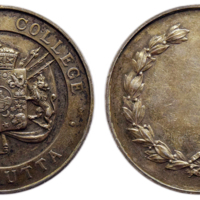Armenian College of Calcutta Award Medal
Identifier
ANRO-1221
Reference Description
Obverse: Inscribed “ARMENIAN COLLEGE” above and “CALCUTTA” below, encircling a central coat of arms. The shield is surmounted by a crown and flanked by two lions, with crossed spears or banners behind, reflecting the institution’s heraldic identity.
Reverse: Adorned with a laurel wreath framing a plain central field, typically left blank for inscriptions or dedications.
Specifications: Silver, 31.5mm, 13.47 g, 12h
Artist / Engraver:
Mint:
Edge: Plain
Mintage:
Reference: Puddester-948.88
Image shown:
Reverse: Adorned with a laurel wreath framing a plain central field, typically left blank for inscriptions or dedications.
Specifications: Silver, 31.5mm, 13.47 g, 12h
Artist / Engraver:
Mint:
Edge: Plain
Mintage:
Reference: Puddester-948.88
Image shown:
Items in Catalog Category
Citation
“Armenian College of Calcutta Award Medal,” Armenian Numismatic Research Organization, accessed March 29, 2025, https://armnumres.org/items/show/1221.


